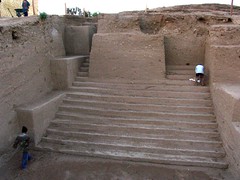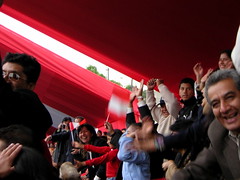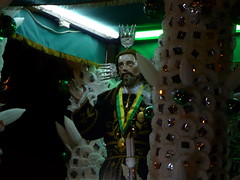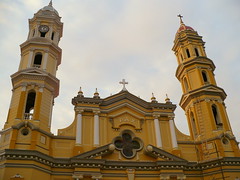Lord of Ucupe: “King of Bling” Tomb Sheds Light on Ancient Peru [Featured]
I wrote some time ago about the stunning archaeological find at a dig led by Canadian Steve Bourget of the University of Texas. Invoking memories of Walter Alva’s spectacular and world renowned discovery of the Señor de Sipán tomb in 1987, a new tomb containing the 1700 year old remains of a person buried with hundreds of precious ornaments was discovered.
Living in a similar period of time as his more famous neighboring Moche king at Sipán, this man, also a king, seems to have been of similar power, wealth and importance.
The archaeological dig took place in Úcupe, some 39 kilometres from Chiclayo in Lambayeque. A expert in the Moche culture and known for his work on the Huaca de la Luna near Trujillo, Bourget was accompanied by Bruno Alva Meneses, son of Walter Alva. For him, experiencing what were perhaps the same emotions as his father, reliving his father’s experience from all those years ago, was more than he could have hoped for.
Here is the follow-up by National Geographic News:
Packed with treasure in the styles of two ancient orders, the 1,500-year-old tomb of the Moche Indian “king of bling” is like no other, according to archaeologist Steve Bourget. Discovered in Peru at the base of an eroded mud-brick pyramid, the tomb gradually yielded its contents last summer.
Among the finds: 19 golden headdresses, various pieces of jewelry, and two funerary masks, as well as skeletons of two other men and a pregnant woman.

Found in a treasure-filled tomb of the Moche culture in Peru in June 2008, this 1,500-year-old gilded-copper-and-seashell funerary mask was one of two that shielded the face of the so-called Lord of Ucupe. As in his tomb, the Lord of Ucupe in life would have been covered nearly head to toe in shining metal, so as to dazzle and distract his subjects—"This is the king of bling, literally," one archaeologist says. Photograph courtesy Dr. Steve Bourget
The tomb’s mysterious contents and location—far from known Moche capitals—could shed new light on this little-known culture of Peru’s arid northern coast, said Bourget, of the University of Texas at Austin.
Thriving between A.D. 100 and 800, the highly agricultural Moche Indians are known in large part by their stepped pyramids, jewelry-filled tombs, and exquisite pottery and art.
Lord of Ucupe
Located some 475 miles (750 kilometers) north of Lima, the newfound tomb was found at the base of Huaca el Pueblo, a mud-brick, stepped pyramid that has eroded into a high, round mound.
The Lord of Ucupe—as locals have come to call the entombed Moche leader—was in his early thirties when he died, Bourget said.
For entombment, the lord was dressed in full regalia—and then some.
His body was covered with a tunic and train of tiny gilded copper plates, and his face was covered with two funerary masks—a first, according to Bourget. A necklace of four-inch (ten-centimeter), disk-shaped silver rattles encircled his neck.
On his head was a gilded crown. Six more crowns and ten V-shaped headdresses called diadems were arrayed on top of his body. Still another diadem was folded in half and placed atop six metal war clubs to serve as a mat for his lifeless body.
The Lord of Ucupe was then wrapped in a large bundle made of reed and textile, along with artifacts suggestive of political status, said Bourget, who co-led the team that found the tomb with Bruno Alva of the Museum Tumbas Reales de Sipán.
Tags: chiclayo, lambayeque, moche, señor de sipán, steve bourget, ucupe, walter alva



![The ‘Peruvian vampire’ from East Lancashire [Featured]](http://farm3.static.flickr.com/2309/2480614039_07613f3a63_m.jpg)






